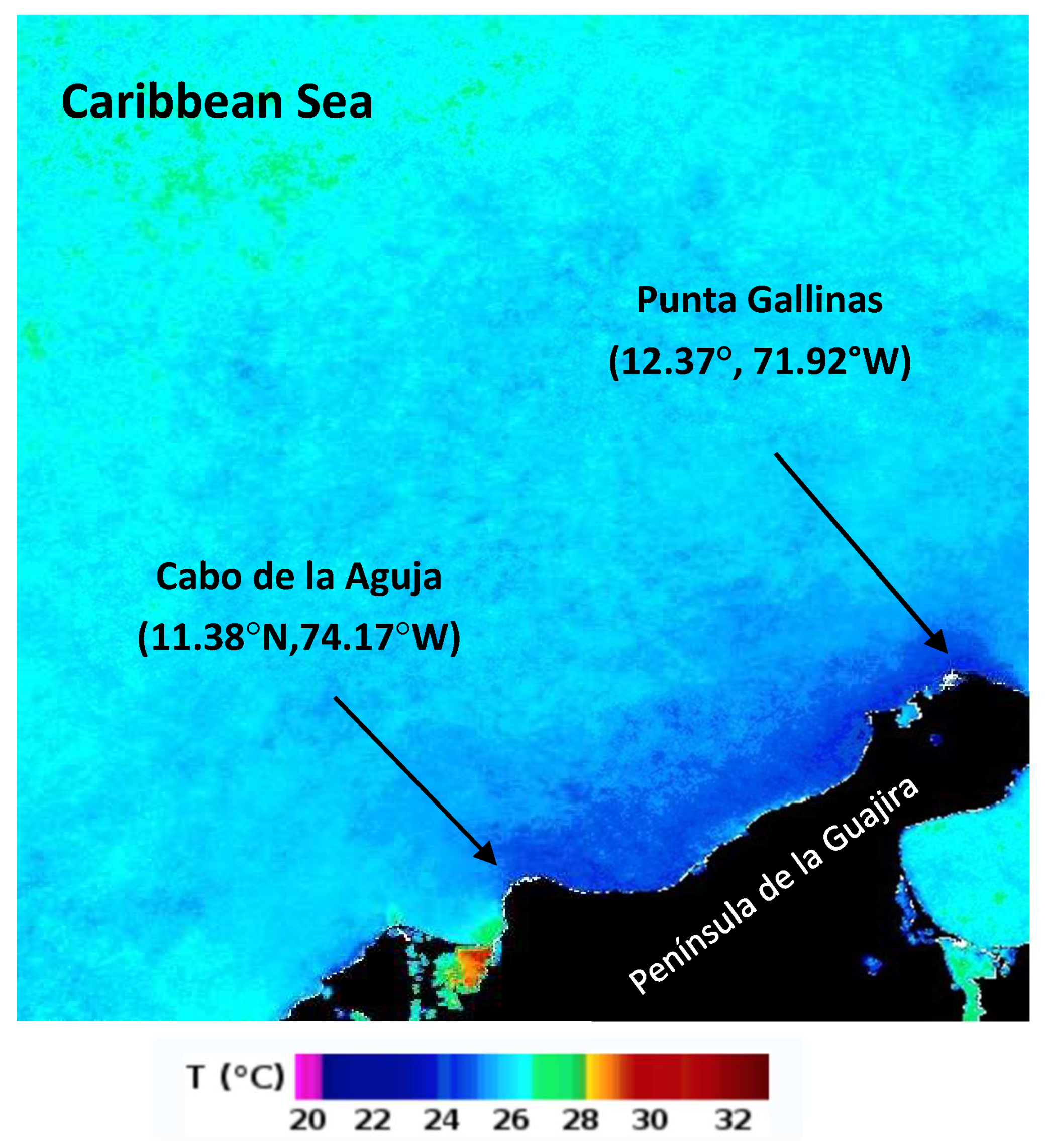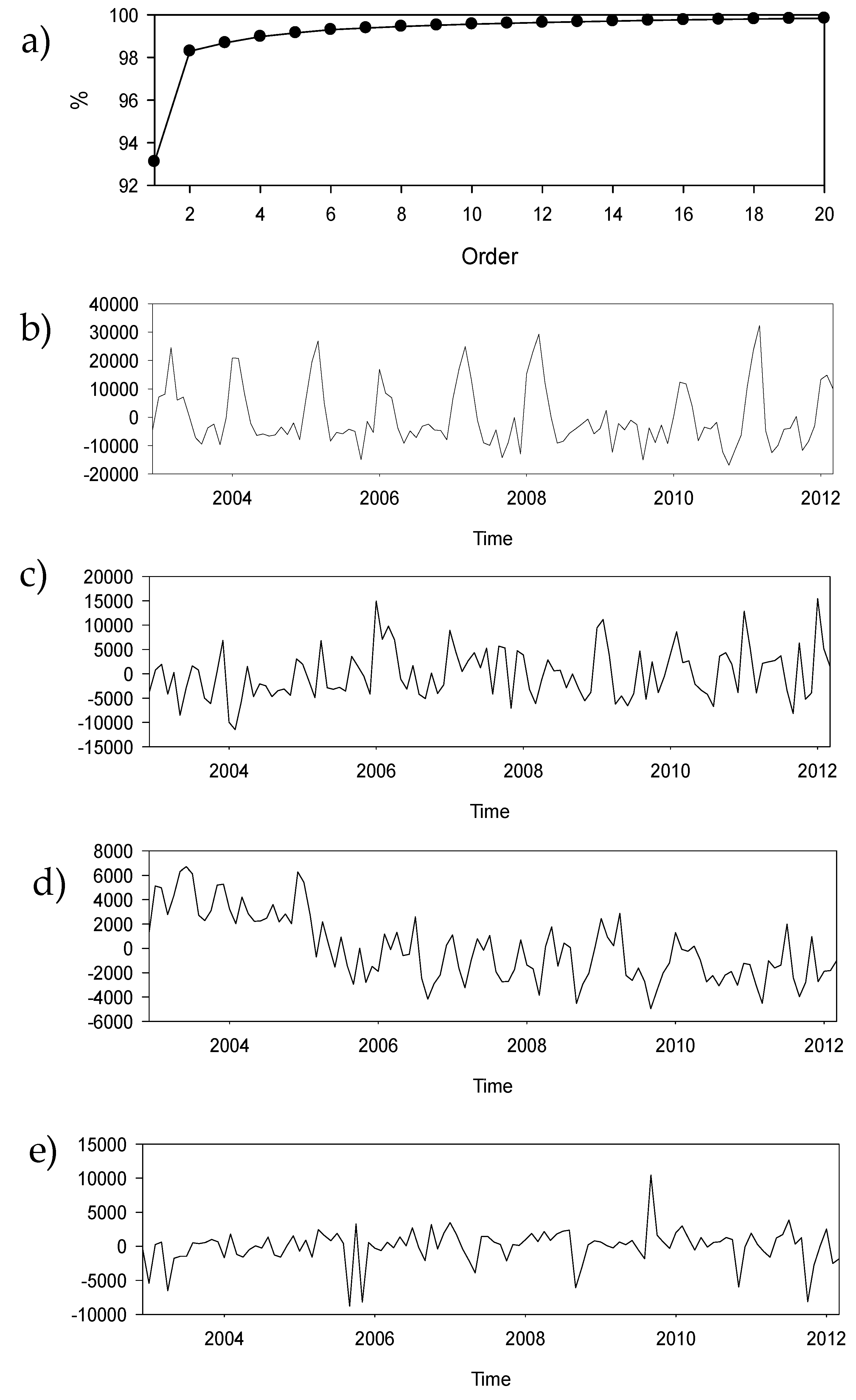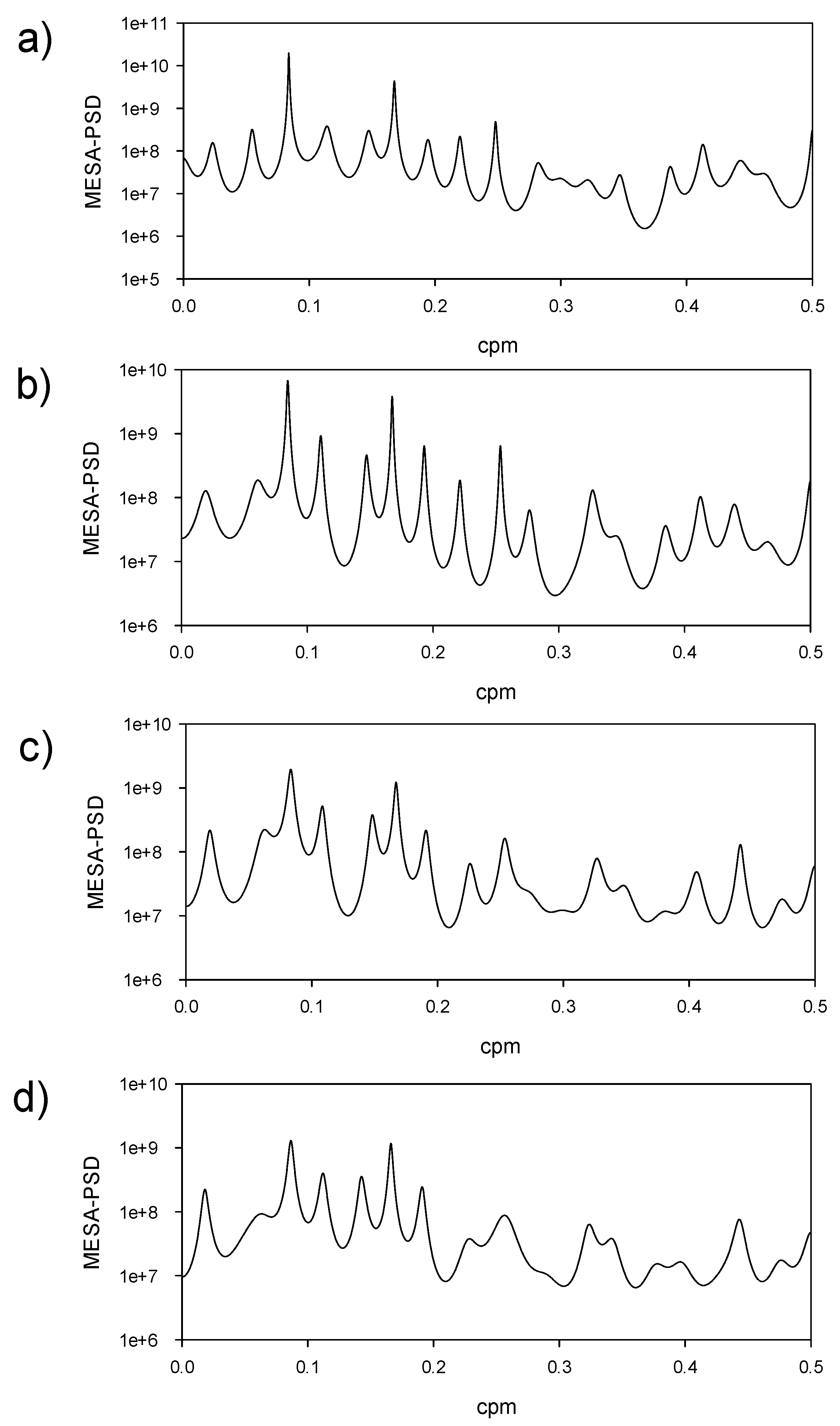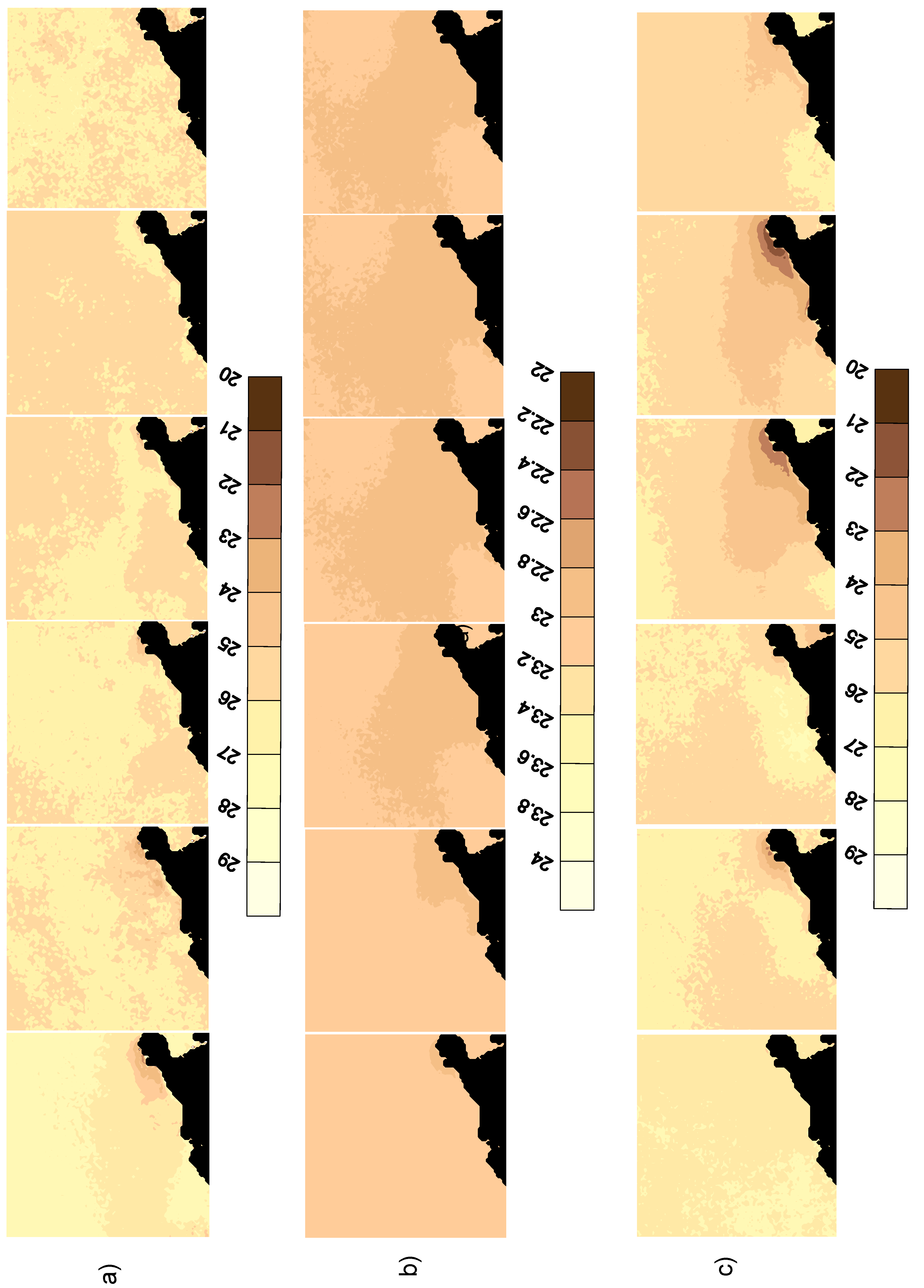On the Prediction of Upwelling Events at the Colombian Caribbean Coasts from Modis-SST Imagery
Abstract
1. Introduction
2. Materials and Methods
2.1. Satellite SST Imagery
2.2. The Karhunen–Loève Transform
2.3. Time-Series Prediction Models
2.3.1. Parametric Time-Series Models
2.3.2. Harmonic Prediction Model
3. Results and Discussion
3.1. KLT
3.2. A Prediction Model for the Upwelling Events
4. Conclusions
Author Contributions
Funding
Acknowledgments
Conflicts of Interest
References
- Chollet, I.; Klein, E. Identificación de focos de surgencia y caracterización de la dinámica de los afloramientos en el sur del mar caribe. In II Jornadas Nacionales de Geomática; Fundación Instituto de Ingeniería y Centro de Procesamiento Digital de Imágenes: Mérida, Venezuela, 2007. [Google Scholar]
- Fajardo, G.E. Surgencia costera en las proximidades de la península colombiana de la Guajira (Coastal upwelling in the proximity of the Colombian peninsula of La Guajira). Boletín Científico CIOH 1979, 2, 7–19. [Google Scholar] [CrossRef]
- Andrade, C.A.; Barton, E.D. The Guajira upwelling system. Cont. Shelf Res. 2005, 25, 1003–1022. [Google Scholar] [CrossRef]
- Müller-Karger, F.E.; McClain, C.R.; Fisher, T.R.; Esaias, W.E.; Varela, R. Pigment distribution in the Caribbean Sea: Observations from Space. Prog. Oceanogr. 1989, 23, 23–69. [Google Scholar] [CrossRef]
- Andrade, C.A. Variabilidad anual del contenido de carbón orgánico en la superficie del Caribe occidental desde CZCS. (Annual variability of organic carbon content at the western Caribbean Sea surface from CZCS). Boletín Científico CIOH 1995, 16, 15–24. [Google Scholar] [CrossRef]
- Castellanos, P.; Varela, R.; Müller-Karger, F. Descripción de las áreas de surgencia al sur del Mar Caribe examinadas con el sensor infrarrojo AVHRR. Mem. Fund. Salle Cienc. Nat. 2002, 154, 55–76. [Google Scholar]
- Pétus, C.; García-Valencia, C.; Thomas, Y.F.; Cesaracio, M. Étude de la variabilité saisonnière et interannuelle de la résurgence de la Guajira (Colombie) par analyse de données satellitaires Ami-Wind, Sea Winds et AVHRR. (Study of the seasonal and interannual variability of the Guajira upwelling Colombia based on the analysis of Ami-Wind and AVHRR satellite data). Revue Télédétection 2007, 7, 143–156. [Google Scholar]
- Chiang, J.C.; Kushnir, Y.; Giannini, A. Deconstructing Atlantic Intertropical Convergence Zone variability: Influence of the local cross-equatorial sea surface temperature gradient and remote forcing from the eastern equatorial Pacific. J. Geophys. Res. Atmos. 2002, 107, ACL-3. [Google Scholar] [CrossRef]
- Wang, C.; Lee, S.-K. Atlantic warm pool, Caribbean low-level jet, and their potential impact on Atlantic hurricanes. Geophys. Res. Lett. 2007, 34, L02703. [Google Scholar] [CrossRef]
- Wang, C.; Lee, S.-K.; Enfield, D. Climate response to anomalously large and small Atlantic warm pools during the summer. J. Clim. 2008, 21, 2437–2450. [Google Scholar] [CrossRef]
- Cook, K.; Vizy, E. Hydrodynamics of the Caribbean low-level jet and its relationship to precipitation. J. Clim. 2010, 23, 1477–1494. [Google Scholar] [CrossRef]
- Alonso, J.; Blázquez, E.; Isaza, E.; Vidal, J. Internal structure of the upwelling events at Punta Gallinas (Colombian Caribbean) from MODIS-SST imagery. Cont. Shelf Res. 2015, 109, 127–134. [Google Scholar] [CrossRef]
- Blázquez, E.; Alonso, J.; Vidal, J. On the sensitivity of the fractal dimension of the skeleton of the sea surface temperature signatures from upwelling events on the spatial resolution and threshold: Application on imagery of the Caribbean Sea. Int. J. Remote Sens. 2017, 38, 371–390. [Google Scholar] [CrossRef]
- Blázquez, E.; Alonso, J.; Vidal, J. On the Outflow of Lake Maracaibo, Venezuela. Reg. Stud. Mar. Sci. 2017, 15, 31–38. [Google Scholar] [CrossRef]
- Marple, S.J.L. Digital Spectral Analysis with Applications; Prentice Hall Inc: Upper Saddle River, NJ, USA, 1987. [Google Scholar]
- Observatorio Oceanográfico Digital de Venezuela. Available online: http://ood.intecmar.usb.ve (accessed on 27 June 2019).
- Centro Control Contaminación del Pacífico (CCCP). Compilación Oceanográfica de la Cuenca Pacífica Colombiana; Dirección General Marítima: Tumaco, Colombia, 2002; ISBN 958-33-3869-9. [Google Scholar]
- Karhunen, K. Zur Spektraltheorie Stochastischer Prozesse. Ann. Acad. Sci. Fenn. Ser. AI 1946, 34, 3–79. [Google Scholar]
- Loève, M.M. Probability Theory; VanNostrand: Princeton, NJ, USA, 1955. [Google Scholar]
- Hotelling, H. Analysis of a complex of statistical variables into principal components. J. Educ. Psychol. 1953, 24, 417–441. [Google Scholar] [CrossRef]
- Stewart, G.W. On the Early History of the Singular Value Decomposition. SIAM Rev. 1993, 35, 551–566. [Google Scholar] [CrossRef]
- Fukunaga, K. Introduction to Statistical Recognition; Academic Press: San Diego, CA, USA, 1990. [Google Scholar]
- Burl, J.B. Reduced-order system identification using the Karhunen-Loève transform. Int. J. Model. Simul. 1993, 13, 183–188. [Google Scholar] [CrossRef]
- Yamashita, Y.; Ogawa, H. Relative Karhunen-Loève Transform. IEEE Trans. Signal Process. 1996, 44, 371–378. [Google Scholar] [CrossRef]
- Kirby, M.; Sirovich, S. Application of the Karhunen-Loève Procedure for the characterization of human faces. IEEE Trans. Pattern Anal. Mach. Intell. 1990, 12, 103–108. [Google Scholar] [CrossRef]
- Murase, H.; Nayar, S. Visual learning and recognition of 3-D objects from appearance. Int. J. Comput. Vis. 1995, 14, 5–24. [Google Scholar] [CrossRef]
- Berberian, S.K. Introduction to Hilbert Spaces; Oxford University Press: Oxford, UK, 1961. [Google Scholar]
- Peña Sánchez de Rivera, D. Análisis de Series Temporales; Alianza Editorial: Madrid, Spain, 2005; ISBN 978-84-206-9128-2. [Google Scholar]
- Vandaele, W. Applied Time Series and Box-Jenkins Models; Academic Press: Orlando, FL, USA, 1983; ISBN 0127126503. [Google Scholar]






| Mode | Period (Months) |
|---|---|
| 1 | 11.9, 6.8 |
| 2 | 11.9, 9.0, 6.8, 6.0, 5.2, 4.0 |
| 3 | 54.3, 11.9, 9.0, 6.8, 6.0, 5.2, 4.0 |
| 4 | 54.3, 11.9, 9.0, 6.8, 6.0, 5.2, 4.0 |
| Months | ARMA | Harmonic |
|---|---|---|
| April | 0.9760 | 0.8130 |
| May | 0.9103 | 0.8154 |
| June | 0.7278 | 0.8091 |
| July | 0.5855 | 0.8007 |
| August | 0.4366 | 0.7939 |
| September | 0.5123 | 0.8043 |
© 2019 by the authors. Licensee MDPI, Basel, Switzerland. This article is an open access article distributed under the terms and conditions of the Creative Commons Attribution (CC BY) license (http://creativecommons.org/licenses/by/4.0/).
Share and Cite
Alonso del Rosario, J.J.; Vidal Pérez, J.M.; Blázquez Gómez, E. On the Prediction of Upwelling Events at the Colombian Caribbean Coasts from Modis-SST Imagery. Sensors 2019, 19, 2861. https://doi.org/10.3390/s19132861
Alonso del Rosario JJ, Vidal Pérez JM, Blázquez Gómez E. On the Prediction of Upwelling Events at the Colombian Caribbean Coasts from Modis-SST Imagery. Sensors. 2019; 19(13):2861. https://doi.org/10.3390/s19132861
Chicago/Turabian StyleAlonso del Rosario, José J., Juan M. Vidal Pérez, and Elizabeth Blázquez Gómez. 2019. "On the Prediction of Upwelling Events at the Colombian Caribbean Coasts from Modis-SST Imagery" Sensors 19, no. 13: 2861. https://doi.org/10.3390/s19132861
APA StyleAlonso del Rosario, J. J., Vidal Pérez, J. M., & Blázquez Gómez, E. (2019). On the Prediction of Upwelling Events at the Colombian Caribbean Coasts from Modis-SST Imagery. Sensors, 19(13), 2861. https://doi.org/10.3390/s19132861





